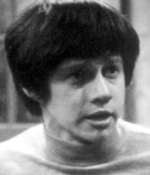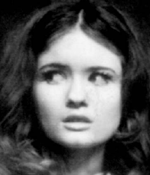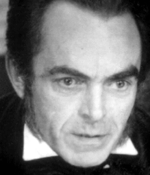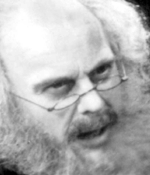| |
 TV
Serial Home TV
Serial Home
 The
Plot The
Plot
 Cast
and Crew Cast
and Crew
 Background Background
 Production Production
 Broadcast Broadcast
 Continuity Continuity
 Deletion Deletion
|
|
Doctor Who - The Evil of the Daleks - Introduction
The Evil of the Daleks was a seven-episode
adventure broadcast been 20th May and 1st July 1967. It starred
Patrick Troughton and Frazer Hines, and introduced Deborah
Watling as Victoria. It was written by David Whitaker and
directed by Derek Martinus. It's serial code was LL and it
was the 36th Doctor Who adventure to be produced.
The Plot
Following directly on from the events of The
Faceless Ones, the Doctor and Jamie are on contemporary
Earth on the trail of their stolen TARDIS. Following some
detective work they find Edward Waterfield's antique shop
and a hidden room containing alien technology. Waterfield
has set a trap for them and they are gassed and taken back
to 1866 where they meet a co-conspirator, Theodore Maxtible.
The Doctor learns about Maxtible and Waterfield's experimentation
with static electricity and mirrors, in trying to create a
time machine. Soon the Daleks reveal themselves as the driving
force behind the unfolding plans, using Waterfield's daughter
Victoria to blackmail him. The Doctor is forced by the Daleks
to conduct an experiment on Jamie, tricking the youngster
into rescuing Victoria, and in doing so, provides the data
the Doctor needs to give the Daleks what they want - The Human
Factor. Once implanted into three Daleks named Alpha, Beta
and Omega, they develop child-like behaviour, wanting to play
and make friends.
Waterfield's house is destroyed and the action moves to the
planet Skaro where the Doctor, Jamie and Waterfield meet the
Emperor Dalek who reveals the Human Factor will actually show
them what the Dalek Factor is. The Doctor is ordered to spread
the Dalek Factor through the entire history of Earth. Via
a conversion-arch, Maxtible becomes the first Dalekised-Human,
with the Doctor apparently second. Because Humanised Daleks
are still on the loose the Doctor suggests that if all Daleks
are systematically put through the arch then the Human Factor
will be wiped out. However the Doctor has switched the arch
and all Daleks passing through it become humanised. Civil
war erupts between the two Dalek factions. Waterfield sacrifices
himself for the Doctor who escapes with Jamie and Victoria
as the Dalek city explodes in flames.
Cast and Crew
| Doctor Who |
Patrick Troughton |
| Jamie McCrimmon |
Frazer Hines |
| Victoria Waterfield |
Deborah Watling |
| Edward Waterfield |
John Bailey |
| Theodore Maxtible |
Marius Goring |
| Ruth Maxtible |
Brigit Forsyth |
| Perry |
Geoffrey Colville |
| Kennedy |
Griffith Davies |
| Bob Hall |
Alec Ross |
| Toby |
Windsor Davies |
| Kemel the Turk |
Sonny Caldinez |
| Arthur Terrall |
Gary Watson |
| Mollie Dawson |
Jo Rowbottom |
| Dalek Voices |
Peter Hawkins
Roy Skelton |
| Dalek Operators |
Robert Jewell
Gerald Taylor
John Scott Martin
Murphy Grumbar
Ken Tyllsen |
| |
|
| Writer |
David Whitaker |
| Director |
Derek Martinus |
| Producer |
Innes Lloyd |
| Theme music |
Ron Grainer and
the BBC Radiophonic Workshop |
| Incidental music |
Dudley Simpson |
| Daleks Created by |
Terry Nation |
| Fight Arranger |
Peter Diamond |
| Story Editors |
Gerry Davis
Peter Bryant |
| Costumes |
Sandra Reid |
| Make-up |
Gillian James |
| Lighting |
Wally Whitmore |
| Sound |
Bryan Forgham |
| Film Cameraman |
John Baker |
| Film Editor |
Ted Walters |
| Visual Effects |
Michaeljohn Harris
Peter Day |
| Designer |
Chris Thompson |
Dalek fight film
sequence director |
Timothy Combe |
|
|
|
|





|
Background
The 'Space Security Service' and Sara Kingdom
were created by Terry Nation for the 1965 serial The Daleks'
Master Plan. Nation was eager to use these two elements
as the core of a spin-off series in which they would do battle
against his Daleks. Whilst work was under way on the debut
of the Second Doctor, The Power of the Daleks, Nation
took the spinoff idea to the BBC in November 1966 and he suggested
that production should begin on his pilot entitled The
Destroyers before Christmas.
But the BBC did not like the idea and Nation decided to take
his pilot across the Atlantic to NBC. In case the option was
taken up abroad, the production office decided to write the
Daleks out of Doctor Who for good and conceived of
a story in which they met their final end in an epic battle.
For the third story in a row, Nation surrendered writing duties,
and like The Power of the Daleks, the story was penned
by David Whitaker who provided his story outline in January
1967. Nation was paid £15 for each episode in which
his creations featured.
Whitaker was ideally positioned to write this adventure as
it featured a multitude of ideas which harked back to the
very start of the series, of which he was a part. The Doctor's
oldest enemies would be supposedly destroyed, and the story
would move from the present day, to the past, and then to
the Dalek planet, exactly as the first six episodes of the
TV series did in 1963. Furthermore it would see the Doctor
behaving in a more manipulative way, much as the first Doctor
did, and with Jamie left alone to be the hero, as Ian often
was, the Doctor would be left working apparently with the
enemy.
In Whitaker's early story idea, the Human Factor was to be
found in a caveman called Og and the Doctor and Waterfield
had to travel back to 20,000 BC to find him. This was the
only real difference to the plot, with all the other elements
present from the outset, including the Daleks using the Human
Factor against mankind and the story would still have ended
in a pitch Dalek battle. Ben and Polly featured in the whole
of the story meanwhile Jamie was held hostage by the Daleks
along with the relatively minor character of Victoria.
Innes Lloyd and Gerry Davies made the decision to partially
write Ben and Polly out though, and David Whitaker was asked
to leave them on Earth during episode two. As a consequence
David Ellis and Malcolm Hulke who were writing The Faceless
Ones at the time, were asked to mould a female character
into a suitable companion. David Whitaker also fleshed out
Victoria's character to this end, to allow the producers a
choice from which to elect their new regular. Subsequently
Ben and Polly were written out in the previous story, despite
their contracts running for two extra episodes.
The idea of having two options for a new lead female backfired
when they chose the modern-day character of Samantha from
The Faceless Ones, only to find that actress Pauline
Collins had no desire to take up a permanent role. Innes Lloyd
had to fall back on his rejected choice, and have Victoria
as the new companion. Once again, these plans went wrong when
auditions in March and April of 1967 resulted in Denise Buckley
being cast in the role. But after she had done a camera test
on 11th April and was contracted and paid for six episodes,
two days later she was dropped. The role was given to Deborah
Watling, who hadn't even been listed at the audition.
Deborah Watling was contracted for six episodes and producer
Innes Lloyd included an option in her contract for both the
following The Tomb of the Cybermen and the first
story to be recorded in the next season block, The Abominable
Snowmen.
Production
The first recording work done was on location
at Grim's Dyke Mansion House at Harrow Weald in Middlesex
which was to be used both as Maxtible's mansion and the setting
for some contemporary Earth scenes. The Gatwick Airport material
was shot at Kandal Avenue Hangars in Ealing and the railway
arches scene was completed at Warehouse Lane in Shepherd's
Bush. The recording dates were April 20th, 21st, 24th and
25th. Studio filming took place at Ealing in the days thereafter
with extra days added in mid-May to pick up shots of the Dalek
battle in the city, and also some scenes with the Doctor to
allow Patrick Troughton a holiday during episode four.
Sydney Newman was mindful that the Daleks could still return
and some felt that a spinoff would always fail, especially
in America where the popularity of Doctor Who was
not significant enough to launch the Daleks without their
parent show as a popular platform. For this reason Newman
asked director Derek Martinus to include a shot to suggest
that the 'final end' might not be quite so final.
This story was transitional in many ways. As well as Michael
Craze and Anneke Wills being replaced, both story editor Gerry
Davis and producer Innes Lloyd were were moving on too. Peter
Bryant thus became promoted to script editor, but was also
given a trial run as producer for the following The Tomb
of the Cybermen. Actor and writer Victor Pemberton was
brought in to assist in script editing.
Broadcast
The story was well-received at the time, with
the final episode showing a high audience appreciation figure
and contemporary audience reaction, particularly amongst children,
showed strong disappointment at the idea that the Daleks could
be gone for good.
The story was repeated in 1968 at the end of season five,
but was worked into the narrative as the Doctor showed new
companion Zoe what she could expect if she joined him and
Jamie in their adventures.
| # |
Unused Title |
Date |
Time |
Duration |
Viewers |
Pos |
App* |
| 1 |
To Set A Trap... |
20th May 67 |
6.00pm |
24'07" |
8.1m |
37th |
51% |
| 2 |
The Net Tightens |
27th May 67 |
5.51pm |
25'13" |
7.5m |
37th |
51% |
| 3 |
A Trial Of Strength |
3rd Jun 67 |
5.45pm |
24'27" |
6.1m |
61st |
52% |
| 4 |
A Test Of Skill |
10th Jun 67 |
5.45pm |
24'43" |
5.3m |
51st |
51% |
| 5 |
The Human Factor |
17th Jun 67 |
5.45pm |
25'23" |
5.1m |
62nd |
53% |
| 6 |
[No Title] |
24th Jun 67 |
5.45pm |
24'48" |
6.8m |
38th |
49% |
| 7 |
The End Of The Daleks |
1st Jul 67 |
6.25pm |
24'33" |
6.1m |
50th |
56% |
| |
|
|
|
|
|
|
|
Content and Continuity
In episode two a new Dalek voice artist is
employed for the first time - Roy Skelton. He would go on
to provide Dalek voices for almost every Dalek story until
the series was cancelled in 1989. Although he is the voice
of the first Dalek we see in episode one, he is used primarily
to represent the 'Human' Daleks, whilst veteran and original
voice man Peter Hawkins provides most of the normal Daleks.
One question frequently raised is: when is the story set?
Is is often billed as the final destruction of the Daleks
at the end of time, perhaps to be tied in with the Doctor's
subsequent vapourisation of Skaro in Remembrance of the
Daleks. All this clumsy ret-con is ignoring the fact
that in contemporary terms this was not whole-heartedly meant
as the end of the Dalek race. Firstly, as mentioned above,
Sydney Newman foresaw their potential return and therefore
asked for a hint of them surviving. Secondly in the next Dalek
story, Day of the Daleks, some dialogue was originally
written but edited out in which the Daleks explained that
the civil war had been won, and the 'Human' Daleks had been
destroyed. Therefore, despite subsequent fan attempts to re-jig
Dalek continuity, all the Doctor's encounters with his foes
happen in sequence, relative to him, with the exception of
The Dalek Invasion of Earth and Genesis of the
Daleks. Even these two however maintain continuity, with
The Chase referencing the previous serial, and in
the 70s and 80s every Davros story referring to the previous
one.
This is the first time in the series that the Doctor has returned
to a previous location (although this time he travels without
using the TARDIS). Back-references and heavy continuity were
not a hallmark of early television, because without home-recording
and multiple repeats, viewers did not have such an opportunity
to revise and remember past stories. Up until this point only
the Daleks had warranted more than one return to the show,
with the Cybermen and the 'Meddling Monk' each having appeared
twice.
Deletion
During the late 1960s and throughout most of
the 1970s the BBC took the decision to wipe or destroy videotape
or film from their libraries to make space for new programmes.
The reasons for this were varied, but it fundamentally boiled
down to lack of foresight for a home-viewing market of the
future. Whilst various factors at the time all contributed
towards the seemingly obvious decision being made, all could
have been (and have since been) overcome in order that the
commercial potential of old shows has been realised. At the
time, the actor's union Equity, along with other bodies, ensured
that television shows were limited to a number of repeats
within a certain amount of time. The theory behind this being
that if the repeat potential of shows was capped, then there
would always have to be a continual supply of fresh material
for their workers.
The recordings of Doctor Who were originally done
on large videotape and transferred to 16mm film for overseas
sale. With no procedure in place to archive material, and
no dedicated storage facility, they only had to wait for a
nod from the production department of a particular show, or
from BBC Enterprises to say that tapes were no longer needed,
and they would be destroyed. On 9th March 1967 The Highlanders
became the first Doctor Who story to have its master
tapes wiped and the systematic destruction continued for seven
years, with Fury from the Deep being junked in 1974.
Broadcasters around the world were switching to colour and
so even the film-transfers became of little value.
The Evil of the Daleks episodes 1-6 were wiped in
August 1968 and the final installment survived for nearly
another year before being wiped in September 1969.
And so, along with many other hundreds of episodes, this Dalek
adventure seemed lost for good.
 However,
whilst at a car boot sale in December 1983, film collector
Gordon Hendry bought two 16mm film cans marked as Doctor
Who. Fueled only by his fond memories of the show, and
with no clue as to their value, he paid £8 for episode
two of The Evil of the Daleks, along with episode
three of The Faceless Ones. You can buy
The Evil of the Daleks episode two on DVD here. However,
whilst at a car boot sale in December 1983, film collector
Gordon Hendry bought two 16mm film cans marked as Doctor
Who. Fueled only by his fond memories of the show, and
with no clue as to their value, he paid £8 for episode
two of The Evil of the Daleks, along with episode
three of The Faceless Ones. You can buy
The Evil of the Daleks episode two on DVD here.
A few seconds of the end of episode one survives as a 'mental
projection' on the TARDIS scanner at the end of The Wheel
in Space, but as this is essentially identical to the
recap which survives in episode two it is of very little value.
Only one other clip exists, and this features two model Daleks
moving through the destroyed remains of the Emperor's chamber
in episode seven. It lasts only 3 seconds and forms part of
a 10 second piece of the 'rushes' most of which would have
gone unused as it includes a pair of hands holding the Dalek
models.
More exciting was the discovery of a behind-the-scenes film
called The Last Dalek which was made by the special
effects team at the time to document their creation of the
epic civil war on Skaro at the end of the story. This footage
can be seen on a DVD
release which can be bought here.
Like all the other missing adventures, the story also exists
in it's audio form, thanks to a number of devoted fans who
made off-air home recordings at the time of broadcast. You
can buy The
Evil of the Daleks audio CD here.
For more information on how the fans and the BBC are working
to recreate this story visit the reconstructions
page.
|









 However,
whilst at a car boot sale in December 1983, film collector
Gordon Hendry bought two 16mm film cans marked as Doctor
Who. Fueled only by his fond memories of the show, and
with no clue as to their value, he paid £8 for episode
two of The Evil of the Daleks, along with episode
three of The Faceless Ones. You can
However,
whilst at a car boot sale in December 1983, film collector
Gordon Hendry bought two 16mm film cans marked as Doctor
Who. Fueled only by his fond memories of the show, and
with no clue as to their value, he paid £8 for episode
two of The Evil of the Daleks, along with episode
three of The Faceless Ones. You can